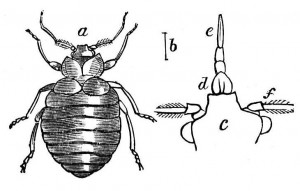Bed Bug Basics
Bed bugs are insects that have no wings and a singular source of nutrition – the blood of animals that are warm blooded. These parasites have been plaguing mankind since ancient times. There are over ninety different kinds of bed bugs found all over the world. The most common of them is the Cimex lectularius, its scientific name. These are usually the bed bugs most often associated with human hots since they are best adapted for environments that humans.
Bed Bug Appearance
Fully grown bed bugs are going to be flat, reddish brown, and have hairs that are microscopic lending them a banded look. They can grow anywhere from 1/8th to 3/16th of an inch (4-5 mm) long. The eggs of a bed bug are extremely small, white, and virtually impossible to see without a magnifying glass. A single egg is roughly the same size as a spec of dust. When the egg is initially laid, it has a sticky outer shell that can make it stick to just about any material. The bed bug nymphs that hatch from this egg are nearly see through and will become darker as they molt on their way to adulthood. Nymphs are only the size of the head of a pin. 
Bed Bug Bites
Bed bugs are most active at night and they are most likely to strike just before dawn. Although, if their human host has a different sleep schedule and dark room, they can be confused on what time it is. Essentially, they will feed anytime someone is sleeping or sitting in an infected area for more than a couple hours. It is the body heat that attracts them, as well as the build-up of carbon dioxide. Bed bugs can go up to 18 months between feeding, but on average will feed every 5-10 days.
The bed bug will bite its host with two tubes that are hollow. One tube injects saliva that has anesthetics, to make it painless, and anticoagulants, to thicken blood and stop bleeding. The second tube is used to suck the host’s blood. The bed bug will feed for approximately five minutes before it goes back in to hiding. Bites are not felt for at minimum of several minutes and have been known to take hours to surface. The injected chemicals are what cause a red rash and itching to appear.
If a person is exposed to bed bugs repeatedly during a short period, they can become even more sensitive to the bed bug saliva. At this point, the allergic reaction to the bed bug bites will become more severe. The lesions in the skin that the bite produces can look like the bites of other parasites that feed on blood, like fleas or mosquitoes. The first time a person experiences a bed bug bite, they may also confuse it with a rash from a spider bite or poison ivy. Often it takes a dermatologist to make the final determination.
More posts like this one in About Bedbugs.


{ 0 comments… add one now }